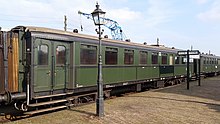Preservation
In the eighties, an electric museum set was constructed from parts of various carriages, consisting of a motor carriage and a carriage with driver position. This set was completely restored and put into service in 1989. In 1994 an intermediate carriage, equipped with a restoration department, was added to increase the rentability for groups. This equipment is now in the collection of the NSM in Utrecht.
The two-car set initially consisted of the motor carriage mBD 9107 and the control car Ces 8104. The latter carriage never existed before: the series consisted of the Ces 8101 up to and including the Ces 8103, built by Beijnes in Haarlem. A "new" Ces 8104 was added to this series at the end of the 20th century in the main workshop in Amersfoort from various remnants of old blokkendozen carriage for the museum train set: the Ces 8104.
The Cecr 8553 intermediate carriage added later has been given the previously never used designation 'r', for restoration.
One of the motor carriages (the Jaap) was also restored in the 1990s by the main workshop Haarlem as a heritage carriage. This mC 9002 carriage has been restored to the original cream-green color scheme from the 1920s and can form a four-car unit together with the museum set of the Railway Museum.
Jules, originally mBD 9006 motor carriage, the other motor carriage that first bore the name Bromvlieg in 1968 and was renamed Jules in 1969, was converted into an ATB measurement carriage in 1976 and painted in the yellow livery. This carriage was taken out of service in 1992, after which it was acquired by the STIBANS in 1997 and painted in the brown livery as motor mail carriage mP 9204. This carriage is not roadworthy.
The Blokkendoos carriages used by the Stoomtrein Goes-Borsele (SGB) and the Veluwsche Stoomtrein Maatschappij (VSM) are pulled by a steam locomotive. There is also a motor carriage and two drawn carriages without museum status at a campsite in Eext.
On 3 November 2006, a Museum Blokkendoos train consisting of six carriages was driven on the mainline for the first time since the last one was withdrawn. This train consisted of the mC 9002, the three carriages of the Railway Museum and two intermediate carriages of the SGB. This made a trip of more than 1000 km through the country, to raise money for a good cause.
On 7 December 2013, four journeys were made with Blokkendoos carriages on the Zwolle – Lelystad route on the occasion of the first anniversary of the Hanzelijn. 150 inhabitants of surrounding cities received a special train ticket from the Dutch Railways. [4]























